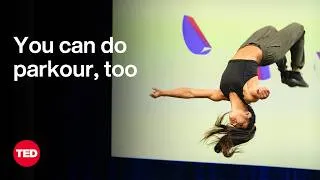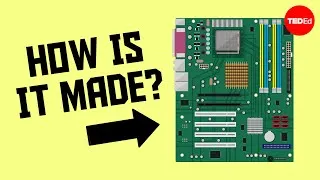請雙擊下方英文字幕播放視頻。
譯者: Lilian Chiu
審譯者: Helen Chang
00:06
While most people wouldn’t consider
the crusty exterior of an oyster
0
6878
3753
雖然大部分人不認為
牡蠣的堅硬外殼
00:10
to be particularly beautiful,
1
10631
1794
有什麼特別漂亮之處,
00:12
opening up this craggy case might reveal
an exquisite jewel nestled within.
2
12675
5672
但打開這粗糙不平的外殼可能會露出
安臥在內的精美珍寶。
00:18
Yet, despite their iridescent colors
and smooth shapes,
3
18973
3670
然而儘管珍珠的
顏色燦爛且形狀光滑,
00:22
pearls are actually made
of the exact same material
4
22643
3712
其實珍珠的組成材料
00:26
as the shell that surrounds them.
5
26355
1877
和它們的外殼相同。
00:28
Pearls, urchin spines, the shells
of mussels, snails and clams, even coral—
6
28566
5464
珍珠、海膽的刺、蚌類的殼、
蝸牛和蛤蜊,甚至珊瑚——
00:34
all these structures are made
out of the same chemical compound:
7
34030
4337
所有這些構造都是
由同樣的化合物組成:
00:38
calcium carbonate.
8
38367
1919
碳酸鈣。
00:40
So, how does this single ingredient form
such a vast array of materials?
9
40745
6006
這單一種成分,如何能
形成這麼多樣化的材料?
00:47
Calcium carbonate, or CaCO3,
is common on land,
10
47919
4045
碳酸鈣,即 CaCO3,
在陸地上很常見,在海中更是豐富。
00:51
and even more bountiful in the sea.
11
51964
2419
00:54
The Earth’s crust is rich in calcium,
12
54550
2586
地球的地殼富含鈣,經過數百年,
00:57
and over millennia these deposits
have seeped into rivers and oceans.
13
57136
4713
這些沉澱物漸漸滲流到河中和海中。
01:02
This is especially true
near hydrothermal vents,
14
62266
3045
這個現象在深海溫泉區更是明顯,
01:05
where hot seawater mingles
with calcium rich basalts.
15
65311
4213
在那裡,熱海水
混合富含鈣的玄武岩。
01:10
Meanwhile, when carbon dioxide in the air
interacts with seawater
16
70024
4088
同時,當空氣中的二氧化碳
和海水產生交互作用,
01:14
it eventually produces
dissolved carbonate.
17
74112
3003
最終會產生出溶解的碳酸鹽。
01:17
Every year, the ocean absorbs roughly
one third of our carbon dioxide emissions,
18
77490
5839
每年,海洋會吸收
大約三分之一我們
排放出來的二氧化碳,
01:23
adding huge quantities of carbonate
into the water.
19
83329
3796
讓水中增加大量的碳酸鹽。
01:27
It’s no surprise that sea creatures have
made use of these abundant compounds,
20
87834
4879
海洋生物會善用如此充足的
化合物,並不讓人意外。
01:32
but the way calcium and carbonate are
woven together into various shapes
21
92713
4422
但鈣和碳酸鹽交織在一起
成為各種形狀的方式
01:37
is surprisingly artful.
22
97135
2168
卻巧妙到讓人吃驚。
01:39
Let’s return to the humble oyster.
23
99846
2419
咱們再回到卑微的牡蠣。
01:42
Like many aquatic mollusks,
oysters start life as exposed larvae,
24
102431
5172
和很多水中的軟體動物一樣,
牡蠣剛誕生時,是暴露在外的幼體,
01:47
and quickly get to work building
a protective shell.
25
107687
3170
牠很快就開始動工
建造保護用的外殼。
01:51
First, an organ called the mantle secretes
an organic matrix
26
111065
3837
首先,叫做「套膜」的器官
會分泌蛋白質及其他分子的
有機基體,以建造骨架。
01:54
of proteins and other molecules
to construct a scaffold.
27
114902
3629
01:58
Then, the oyster filters the seawater,
28
118865
2460
接著,牡蠣會過濾海水,
02:01
drawing out calcium and carbonate to
combine them into its building material.
29
121325
4755
取出鈣及碳酸鹽,將兩者結合,
組成建材。
02:06
It lays this material over the scaffold,
30
126664
2419
它把這建材舖在骨架上,
02:09
which is covered in charged proteins
that attract and guide
31
129083
3670
它上面覆蓋著帶電的蛋白質,
能夠吸引和引導碳酸鈣分子
變成一層一層的形式。
02:12
the calcium carbonate molecules
into layers.
32
132753
2837
02:16
The specific arrangement of these protein
scaffolds depends on the mollusk species
33
136257
4504
這些蛋白質骨架會如何排列,
就要看軟體動物的物種
和牠們的環境,
02:20
and their environment,
34
140761
1377
02:22
accounting for their vast diversity
of shell shapes, sizes, and colors.
35
142138
5589
這就說明了為何牠們會有
各式各樣的外殼形狀、
大小,及顏色。
02:28
Mollusks carefully control all components
of their calcium carbonate creations—
36
148269
5589
軟體動物會很小心地控制其
碳酸鈣作品的所有成分——
02:33
even manipulating CaCO3
at the molecular level.
37
153858
4004
甚至在分子層級操控 CaCO3。
02:38
Using special proteins,
38
158362
1585
靠著特殊的蛋白質,
02:39
mollusks can produce
two crystal structures out of CaCO3:
39
159947
4630
軟體動物能用 CaCO3
產生出兩種晶體結構。
02:44
calcite and aragonite.
40
164577
2210
方解石和霰石。
02:47
Both of these compounds have
the same chemical composition,
41
167205
3169
這兩種化合物有同樣的化學組成,
02:50
but different qualities due to the way
their crystal lattices are arranged.
42
170374
4380
但特性不同,
因為它們的晶格排列方式不同。
02:55
Calcite is the more stable of the two
and less prone to dissolving over time,
43
175171
4838
這兩者中,方解石比較穩定,
且比較不會隨時間溶解,
03:00
so most mollusk shells have
a sturdy outer layer of calcite.
44
180009
4421
所以大部分軟體動物的外殼
都有一層堅固的方解石。
03:04
As the slightly more soluble molecule,
45
184805
2461
身為稍為較容易溶解的分子,
03:07
aragonite can better adapt
to more or less acidic environments.
46
187266
4338
霰石對於比較酸/不酸的環境
都能適應較良好。
03:11
So most mollusk shells have
an interior layer of aragonite
47
191604
3754
所以大部分軟體動物的外殼,
裡面都有霰石內層,
03:15
to maintain their internal pH level.
48
195358
2711
維持牠們內部的酸鹼值。
03:18
But one form of aragonite is stronger
and more versatile than the rest:
49
198486
5172
但有一種霰石的形式,
比其他種類更堅固、更多功能:
03:23
nacre.
50
203908
1001
珍珠母。
03:25
Mollusks make this special material
by placing successive layers of aragonite
51
205368
4921
軟體動物製造這種特殊材料的
方式,是把連續數層的霰石
03:30
interspersed with proteins.
52
210289
2127
和蛋白質一起散布排放。
03:32
These layers are stacked
like hexagonal bricks,
53
212583
3212
一層一層如同六角形磗般堆疊起來,
03:35
each surrounded by other organic material
that directs their orientation.
54
215795
4880
每一層都被其他的有機材料
包覆,用來引導其方向。
03:41
The uniform layering and brick-like
structure of nacre
55
221342
3378
珍珠母的一致層疊方式
以及類似磚塊的結構,
03:44
is key to its signature iridescence.
56
224720
2962
是造成它招牌燦爛色彩的關鍵。
03:47
The layers are similar in thickness
to the wavelength of visible light,
57
227848
3879
各層的厚度和可見光的波長類似,
03:51
so the light reflecting
from its interior surface
58
231727
3254
因此內部表面所反射的光
03:54
interferes with the light reflecting
from the outer surface.
59
234981
3753
會干擾外部表面所反射的光。
03:59
When particles of light strike the nacre,
60
239026
2836
當光的粒子撞擊到珍珠母,
04:01
they bounce around its multilayered
crystalline structure
61
241862
3546
便會在其多層結晶結構中彈來彈去,
04:05
in a cascade of shifting rainbows.
62
245408
3128
產生出一連串不斷變換的彩虹。
04:08
But nacre isn’t just pretty—
63
248911
1835
但珍珠母不僅是漂亮——
04:10
it’s one of the strongest and lightest
biomaterials we know of.
64
250913
4088
它是我們所知最堅固
且最亮的生物材料之一。
04:15
And it's not just oysters that produce it.
65
255251
2294
且不只有牡蠣會製造它。
04:17
In fact, numerous mollusk
species deploy nacre
66
257670
3462
事實上,許多軟體動物物種
都會部署出珍珠母,
04:21
as one of their primary
defense mechanisms.
67
261132
2752
做為牠們主要的防禦機制之一。
04:24
If an intruding parasite or even a stray
particle of sand irritates the mantle,
68
264135
5547
如果有入侵的寄生蟲
或甚至迷路的沙子
刺激到了套膜,
04:29
the mollusk will coat the offender
in nacre-producing cells
69
269682
4087
軟體動物會用產生珍珠母的
細胞把入侵者覆蓋住,
04:33
to form what’s known as a pearl sac.
70
273769
3087
形成一般所知的珍珠囊。
04:37
These cells wrap the threat in layers
of proteins and aragonite
71
277106
4379
這些細胞用數層蛋白質
和霰石把威脅包裏起來,
04:41
until eventually the cocoon
completely absorbs the invader—
72
281485
4421
直到最後繭狀物
完全吸收掉入侵者——
04:46
dissolving the threat into an opalescent
sphere of nacre.
73
286240
4630
把威脅溶解成乳白色的珍珠母球體。
04:51
This defense mechanism is our leading
theory for mollusks making pearls;
74
291370
4797
關於軟體動物為什麼要製造珍珠,
我們主要的理論就是這種防禦機制;
04:56
transforming everyday intruders
into timeless treasures.
75
296167
4838
將日常的入侵者轉換
成為永恆的珍寶。
New videos
關於本網站
本網站將向您介紹對學習英語有用的 YouTube 視頻。 您將看到來自世界各地的一流教師教授的英語課程。 雙擊每個視頻頁面上顯示的英文字幕,從那裡播放視頻。 字幕與視頻播放同步滾動。 如果您有任何意見或要求,請使用此聯繫表與我們聯繫。







